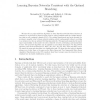Free Online Productivity Tools
i2Speak
i2Symbol
i2OCR
iTex2Img
iWeb2Print
iWeb2Shot
i2Type
iPdf2Split
iPdf2Merge
i2Bopomofo
i2Arabic
i2Style
i2Image
i2PDF
iLatex2Rtf
Sci2ools
ICMLA
2007
2007
Learning bayesian networks consistent with the optimal branching
We introduce a polynomial-time algorithm to learn Bayesian networks whose structure is restricted to nodes with in-degree at most k and to edges consistent with the optimal branching, that we call consistent k-graphs (CkG). The optimal branching is used as an heuristic for a primary causality order between network variables, which is subsequently refined, according to a certain score, into an optimal CkG Bayesian network. This approach augments the search space exponentially, in the number of nodes, relatively to trees, yet keeping a polynomial-time bound. The proposed algorithm can be applied to scores that decompose over the network structure, such as the well known LL, MDL, AIC, BIC, K2, BD, BDe, BDeu and MIT scores. We tested the proposed algorithm in a classification task. We show that the induced classifier always score better than or the same as the Naive Bayes and Tree Augmented Naive Bayes classifiers. Experiments on the UCI repository show that, in many cases, the improv...
Related Content
| Added | 29 Oct 2010 |
| Updated | 29 Oct 2010 |
| Type | Conference |
| Year | 2007 |
| Where | ICMLA |
| Authors | Alexandra M. Carvalho, Arlindo L. Oliveira |
Comments (0)

